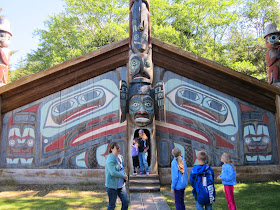After canoeing we visited a Totem Bright, State Historical Park.
I had never really thought of the purpose of totem poles.
I learned a great deal about them.
Our guide was great, and entertained us with fascinating stories.
The meanings of the designs on totem poles are as varied as the cultures that make them. Totem poles may recount familiar legends, clan lineages, or notable events. Some poles celebrate cultural beliefs while others are mostly artistic. Certain types of totem poles are part of mortuary structures, and incorporate grave boxes with carved supporting poles, or recessed backs for grave boxes. Poles illustrate stories that commemorate historic persons, represent shamanic powers, or provide objects of public ridicule.
A community house or clanhouse of this size could have housed 30 to 50 people.
Inside is one large room with a central fireplace surrounded by a planked platform. The walls and floors were hand-adzed to smooth the surface and remove splinters. The dwelling served as living quarters for several families of a particular lineage.
The carved house posts supporting the beams inside symbolize the exploits of Duk-toothl. He is a man of Raven phratry wearing a weasel skin hat who showed his strength by tearing a sea lion in two. The painting on the house front was designed by Charles Brown. It is a stylized Raven with each eye elaborated into a face.


















